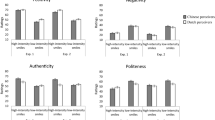Abstract
Theoretically based distinctions linked to measurable differences in appearance are described for three smiles: felt smiles (spontaneous expressions of positive emotion); false smiles (deliberate attempts to appear as if positive emotion is felt when it isn't); and, miserable smiles (acknowledgements of feeling miserable but not intending to do much about it). Preliminary evidence supports some of the hypotheses about how these three kinds of smile differ.
Similar content being viewed by others
Reference Notes
O'Sullivan, M., Ekman, P., & Friesen, W.V. Emotion recognition: measuring affect specific abilities. Manuscript in preparation.
O'Sullivan, M., Ekman, P., Friesen, W.V., & Weiss, A. Judging felt and false smiles. Manuscript in preparation.
Ekman, P.Liars and Lie Catchers. In preparation.
Hager, J.C. Asymmetries in facial actions. Doctoral dissertation in progress. University of California, San Francisco.
Ekman, P., & Friesen, W.V. Organization of facial movement. Manuscript in preparation.
Izard, C. Maximally discriminative facial movement coding system (MAX). Unpublished manuscript. 1979. Available from Instructional Resources Center, University of Delaware, Newark.
References
Birdwhistell, R.L.Kinesics and Context, Philadelphia: University of Pennsylvania Press, 1970.
Darwin, C.The Expression of Emotion in Man and Animals. New York: Philosophical Library, 1955. (Original 1872.)
Ekman, P. Universals and cultural differences in facial expressions of emotion. In J. Cole (Ed.),Nebraska Symposium on Motivation (Vol. 19). Lincoln: University of Nebraska Press, 1972, 207–283.
Ekman, P. Cross-cultural studies of facial expression. In P. Ekman (Ed.)Darwin and Facial Expression: A Century of Research in Review. New York: Academic Press, 1973, 169–222.
Ekman, P. Facial asymmetry.Science, 1980,209, 833–834.
Ekman, P. Mistakes when deceiving.Annals of the New York Academy of Sciences, 1981,364, 269–278.
Ekman, P., & Friesen, W.V. The repertoire of nonverbal behavior: Categories, origins, usage, and coding.Semiotica, 1969a,1, 49–98.
Ekman, P., & Friesen, W.V. Nonverbal leakage and clues to deception.Psychiatry, 1969b,32, 88–105.
Ekman, P., & Friesen W.V. Detecting deception from body or face.Journal of Personality and Social Psychology, 1974,29(3), 288–298.
Ekman, P., & Friesen, W.V.Unmasking the Face: A Guide to Recognizing Emotions From Facial Clues. New Jersey: Prentice Hall, 1975.
Ekman, P., & Friesen, W.V. Measuring facial movement.Environmental Psychology and Nonverbal Behavior, 1976,1(1), 56–75.
Ekman, P., & Friesen, W.V. Investigator's Guide: Part two.Facial Action Coding System. Palo Alto, CA: Consulting Psychologists Press, 1978a.
Ekman, P., & Friesen, W.V.Facial Action Coding System. Palo Alto, CA: Consulting Psychologists Press, 1978b.
Ekman, P., Friesen, W.V., & Ancoli, S. Facial signs of emotional experience.Journal of Personality and Social Psychology, 1980,39(6), 1125–1134.
Ekman, P., Friesen, W.V., & Tomkins, S.S. Facial Affect Scoring Technique: A first validity study.Semiotica, 1971,3, 37–58.
Ekman, P., Hager, J.C., & Friesen, W.V. The symmetry of emotional and deliberate facial actions.Psychophysiology, 1981,18(2), 101–106.
Finkelstein, S. The relationship between physical attractiveness and nonverbal behaviors. Unpublished honors thesis, Hampshire College, 1978.
Friesen, W.V. Cultural differences in facial expression in a social situation: An experimental test of the concept of display rules. Unpublished doctoral dissertation. University of California, San Francisco. 1972.
Hager, J.C., & Ekman, P. Long distance transmission of facial affect signals.Ethology and Sociobiology, 1979,1, 77–82.
Hager, J.C., & Ekman, P. The inner and outer meaning of facial expressions. In J. Cacioppo & R. Petty (Eds.),Social Psychophysiology. New York: Guilford Press, 1982.
Hemsley, G.D. Experimental studies in the behavioral indicants of deception. Unpublished doctoral dissertation. University of Toronto, 1977.
Hocking, J.E., & Leathers, D.G. Nonverbal indicators of deception: A new theoretical perspective.Communication Monographs, 1980,47, 119–131.
van Hooff, J.A.R.A.M. A comparative approach to the phylogeny of laughter and smiling. In R.A. Hinde (Ed.),Nonverbal Communication. Cambridge, England: Cambridge University Press, 1972, 209–238.
Klineberg, O.Social Psychology, New York: Holt, 1940.
Knapp, M.L., Hart, R.P., & Dennis, H.S. An exploration of deception as a communication construct.Human Communication Research, 1974,1, 15–29.
Krauss, R.M., Geller, V., & Olson, C. Modalities and cues in the detection of deception. Paper presented at the meeting of the American Psychological Association, Washington, D.C. September, 1976.
Kraut, R.E. Verbal and nonverbal cues in the perception of lying.Journal of Personality and Social Psychology, 1978,36, 380–391.
Kraut, R.E., & Poe, D. On the line: The deception judgements of customs inspectors and laymen.Journal of Personality and Social Psychology, 1980,39, 784–798.
LaBarre, W. The cultural basis of emotions and gestures.Journal of Personality, 1947,16, 49–68.
Lynn J.G., & Lynn, D.R. Face-hand laterality in relation to personality.Journal of Abnormal & Social Psychology, 1938,33, 291–322.
Lynn, J.G., & Lynn, D.R. Smile and hand dominance in relation to basic modes of adaptation.Journal of Abnormal and Social Psychology, 1943,38, 250–276.
McClintock, C.C., & Hunt, R.G. Nonverbal indicators of affect and deception in an interview setting.Journal of Applied Social Psychology, 1975,5, 54–67.
Mehrabian, A. Nonverbal betrayal of feeling.Journal of Experimental Research in Personality, 1971,5, 64–73.
Miehlke, A.Surgery of the facial nerve. Philadelphia: Saunders, 1973.
Myers, R.E. Comparative neurology of vocalization and speech: Proof of a dichotomy.Annals of the New York Academy of Sciences, 1976,280, 745–757.
O'Hair, H.D., Cody, M.J., & McLaughlin, M.L. Prepared lies, spontaneous lies, Machiavellianism and nonverbal communication.Human Communication Research, 1981,7(4) 325–339.
Redican, W.K. An evolutionary perspective on human facial displays. In P. Ekman (Ed.)Emotion in the Human Face (2nd edition). Cambridge: Cambridge University Press. 1982.
Sackeim, H.A., Gur, R.C., & Saucy, M.C. Emotions are expressed more intensely on the left side of the face.Science, 1978,202, 434–436.
Tomkins, S.S.Affect, Imagery, Consciousness (Vol. 1, The Positive Affects). New York: Springer, 1962.
Tomkins, S.S. The phantasy behind the face.Journal of Personality Assessment, 1975,39, 551–562.
Tschiassny, K. Eight syndromes of facial paralysis and their significance in locating the lesions.Annals of Otology, Rhinology, and Laryngology, 1953,62, 677–691.
Author information
Authors and Affiliations
Additional information
This research was supported by a grant (MH 11976) and a Research Scientist Award (MH 06092) from the National Institute of Mental Health. We are grateful to Maureen O'Sullivan for her suggestions on this report.
Rights and permissions
About this article
Cite this article
Ekman, P., Friesen, W.V. Felt, false, and miserable smiles. J Nonverbal Behav 6, 238–252 (1982). https://doi.org/10.1007/BF00987191
Issue Date:
DOI: https://doi.org/10.1007/BF00987191




